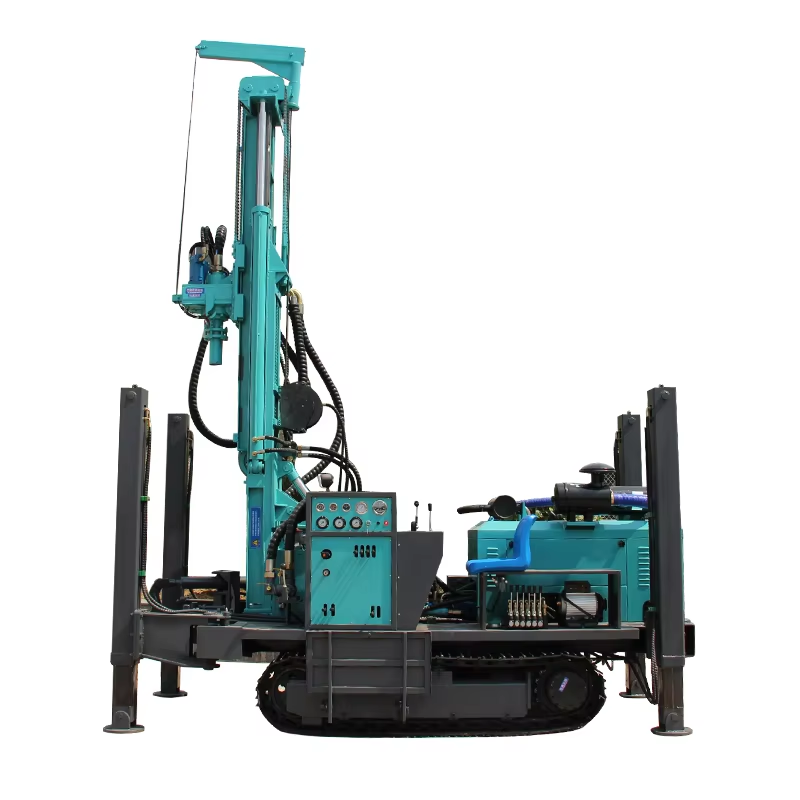Understanding Water Well Drilling Rigs
Definition and Core Purpose
Water well drilling rigs are indispensable tools in accessing groundwater. These complex machines create boreholes that delve deep into the ground to tap into aquifers, providing essential water for agriculture, drinking supplies, and various industrial uses. They function by penetrating different soil and rock layers, allowing for the construction of deep wells with variable diameters. Beyond merely drilling, their core purpose encompasses ensuring water quality and promoting sustainable extraction practices. Through advanced engineering, water well drilling rigs facilitate access to a critical natural resource while helping to maintain the balance of the local ecosystem.
Types of Water Well Drilling Rigs
Exploring the diverse types of water well drilling rigs reveals distinct functionalities tailored to various geological conditions. The major categories include rotary drilling rigs, which employ rotating drill bits to cut through hard materials efficiently. Cable tool rigs, in contrast, use repetitive strokes to penetrate softer formations, offering a cost-effective solution for certain terrains. Auger drilling rigs stand out for their applicability in less dense soil profiles, making them suitable for projects that require shallow depths. Each type boasts unique advantages, from the rapid progress of rotary drilling to the versatility of cable tool and auger rigs in handling diverse geological settings.
Applications in Water Access and Resource Extraction
Water well drilling rigs serve crucial roles in providing clean drinking water, notably in remote and drought-prone regions. Their capability to reach deep aquifers ensures that even the most isolated communities have access to this vital resource. Additionally, these rigs are instrumental in resource extraction, including agricultural irrigation and geothermal energy production—an area where they significantly contribute to sustainable energy solutions. The World Health Organization estimates that enhanced water access, enabled by such rigs, could positively impact millions, underscoring their importance in improving global water security and supporting various industrial and environmental applications.## How Water Well Drilling Rigs Work
Rotary Drilling Technique for Subsurface Penetration
Rotary drilling involves using a rotating drill bit to efficiently penetrate rock and soil layers, opening up the Earth’s subsurface. This technique is widely favored for its effectiveness, particularly when paired with drilling mud, which plays a crucial role in the process. The drilling mud lubricates the drill bit, helping it move more smoothly through the earth, while also stabilizing the borehole to keep it structurally sound during and after drilling. Interestingly, statistics reveal that rotary drilling can easily achieve depths of over 1,000 feet, making it an optimal choice for deeper wells requiring substantial penetration capabilities.
Percussion Drilling for Hard Rock Formations
When dealing with hard rock formations, percussion drilling is a preferred method due to its unique functionality. By continuously dropping a heavy bit onto the rock surface, it breaks the rock into smaller, manageable pieces, effectively penetrating tough geological layers. This technique often complements rotary drilling, enhancing the overall efficiency of drilling operations in particularly challenging environments. Experts frequently recommend percussion drilling methods in areas known for hard bedrock, as it not only aids in penetration but significantly reduces the wear and tear on the drill bit compared to other methods, ultimately extending the lifespan of drilling equipment.
Stabilization and Casing Installation
Stabilization is a critical step in water well drilling to prevent borehole collapse, achieved primarily by casing installation. Casings, typically made of steel or PVC, are inserted into the borehole to maintain structural integrity and ensure the well's usability post-drilling. This protective measure is crucial for safeguarding water quality and preventing contamination. Industry best practices advocate for regular inspections and maintenance of the casing to uphold water well integrity over time. Consistent monitoring helps identify and address any potential issues that could compromise the water quality or the structural soundness of the well.## Key Manufacturers in the Water Well Drilling Industry
Zhejiang Xinyu Machinery Co., Ltd: Expertise and Offerings
Zhejiang Xinyu Machinery Co., Ltd is renowned as a leading manufacturer of robust and durable water well drilling rigs. Their expertise in designing mining drilling machines has allowed them to cater to diverse industry needs, ranging from agriculture to municipal water supply. The company invests heavily in research and development to continually enhance its drilling technologies, ensuring they stay competitive in the evolving market. Their commitment to innovation is evident in the versatility of their products, which are engineered to meet various operational requirements efficiently.
DTH Drill Rigs for Efficient Water Access
Down-The-Hole (DTH) drill rigs have gained prominence due to their efficiency in penetrating hard rock formations, establishing them as a popular choice for large-scale water access projects. These rigs are designed to minimize downtime while maximizing productivity, thus offering a viable solution for efficient drilling in challenging environments. Industry reports highlight how DTH rigs significantly reduce the overall cost of drilling projects, making them a preferred option for companies looking to optimize resource allocation.
Customizable Water Well Drilling Solutions
Key manufacturers are increasingly offering customizable water well drilling solutions tailor-made to address specific project demands. This customization often includes adapting rigs for various soil types, depths, and geographic conditions. The ability to provide solutions that meet client-specific requirements showcases the manufacturers' commitment to enhancing operational flexibility. Current market trends indicate a growing demand for such tailored drilling solutions, underlining the industry's dynamism and adaptability. This shift highlights the role of mining underground machines in meeting bespoke needs within the sector.## Safety and Maintenance Best Practices
Essential Safety Protocols for Rig Operators
Implementing essential safety protocols is crucial for ensuring the welfare of rig operators and minimizing accidents. Regular training sessions on safety procedures are indispensable in preventing injuries associated with drilling operations. This training should encompass various aspects, from handling equipment safely to understanding emergency protocols. Regulatory bodies such as OSHA provide comprehensive guidelines tailored for safe operations in the drilling industry, making adherence to these regulations mandatory for enhancing safety standards. By prioritizing safety, businesses can reduce the risks of accidents and create a safer working environment.
Routine Maintenance for Optimal Performance
Routine maintenance checks are critical to extending the lifespan and maximizing the performance of drilling rigs. Regular inspections of key components like drill bits, hydraulic systems, and electrical components ensure that the equipment is always in optimal working condition. Data reveals that proper maintenance significantly reduces downtime and unexpected repair costs, highlighting its importance in the drilling industry. Routine checks help identify issues before they escalate, thus safeguarding against costly repairs and ensuring uninterrupted operations.
Environmental Considerations
Evaluating environmental considerations is essential before initiating drilling projects to prevent harming ecosystems and adhere to sustainable practices. To minimize ecological impact, businesses should adopt strategies such as efficient waste management and reducing water usage during drilling operations. Compliance with environmental regulations is advocated by experts to ensure that drilling practices are eco-friendly and sustainable. By integrating these considerations into project planning, companies can demonstrate their commitment to protecting the environment while achieving their drilling objectives.
Table of Contents
-
Understanding Water Well Drilling Rigs
- Definition and Core Purpose
- Types of Water Well Drilling Rigs
- Applications in Water Access and Resource Extraction
- Rotary Drilling Technique for Subsurface Penetration
- Percussion Drilling for Hard Rock Formations
- Stabilization and Casing Installation
- Zhejiang Xinyu Machinery Co., Ltd: Expertise and Offerings
- DTH Drill Rigs for Efficient Water Access
- Customizable Water Well Drilling Solutions
- Essential Safety Protocols for Rig Operators
- Routine Maintenance for Optimal Performance
- Environmental Considerations

